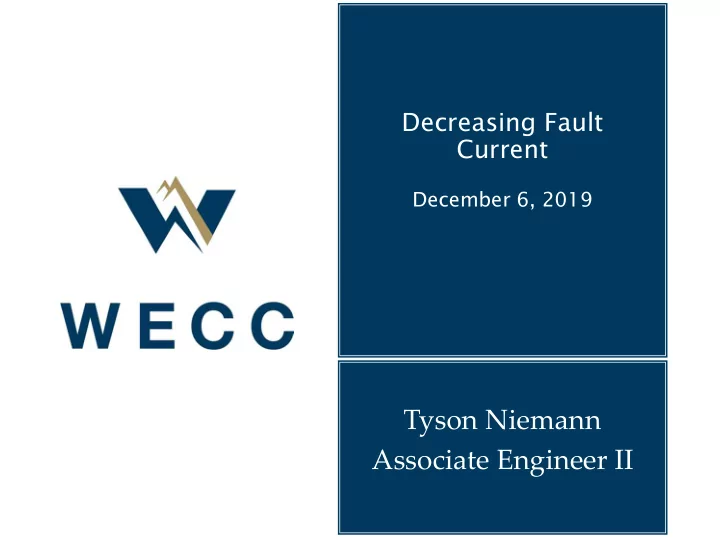

Decreasing Fault Current December 6, 2019 Tyson Niemann Associate Engineer II
Overview • Goal • Data Used • Limitations • Results • Findings • Recommendations and Next Steps 2
Goal • Evaluate the potential fault current in the future based on data received for base case development • To identify potential locations that have dramatically changing in the future 3
Data Used • 2019 Heavy Summer 3 • 2024 Heavy Summer 2 • 2029 Heavy Summer 1 • Location information was extracted from the Geomagnetic Disturbance data collected for TPL-007 • Simulations performed in PowerWorld • 3 Phase balanced bus fault 4
Limitations • Used cases designed for Power Flow to do Short Circuit study • Positive Sequence data only • No Mutual Coupling data • Dynamic data needed for machine impedance • Incomplete location information • Monitored fault current changes of all buses • Results grouped to simplify analysis • Visualization was limited to location information 5
Modifications to Case • Modified 504 dynamic models (REEC_B, REEC_A, WT4G, WT3G) • Type 4 inverters X” were changed to 1 • Type 3 inverters X” were allowed a range from 0.5 to 1 6
Modified 19HS vs 19HS 7
Modified 19HS vs 19HS 100kV+ 8
Results • 287 buses had 25% difference between Modified 19HS3 and 19HS3 • 335 buses had 10-24% difference between Modified 19HS3 and 19HS3 • 500 buses over 50kV that changed by more than 10% • 1214 buses changed by more than 10% 9
19HS3 -> 24HS3 10
19HS3 -> 29HS1 11
Results • 208 buses had 25% difference between 19HS3 and 24HS3 • 335 buses had 10-24% difference between 19HS3 and 24HS3 • 406 buses had 25% difference between 19HS3 and 29HS3 • 407 buses had 10-24% difference between 19HS3 and 24HS3 • 393 buses > 500k amps • 1063 buses > 100k amps • GIS coordinates for 9,285 buses out of 24,548 buses 12
Findings • X” and R” cannot both be 0 • Generally fault current is decreasing in simulations • California was less pronounced than expected • Northwest showed largest changes • Want to understand why • Hypothesis that changes to fault current tied to large generator retirements • Any other ideas? 13
Recommendations/Next Steps • Recommending the System Data Work Group renew efforts to populate X’’ and R’’ accurately • Further investigation by Planning Coordinators and Transmission Planners in areas with significant >25% • Discussion about best practice for reviewing relay settings when changes are made to system • Same study using short-circuit cases? 14
SCMWG Coordination • Short Circuit User’s Preparation Resource – SUPR (short circuit DPM) • Write and maintain the requirements for a common format for transferring short circuit information – WECC SCD format • Research project – creating a WECC wide case • Create best modeling practices document for new technologies (i.e. Inverters) 15
Next Meeting • RWG’s next meeting is March 5 -6 • SCMWG is planned for March 4 th 16
SCMWG Data Request • www.wecc.org • Login • Top left click Program Areas/ Reliability Planning & Performance Analysis/ System Stability Planning • Bottom left column click Short Circuit Models • Click the big tan button labeled “Short Circuit Model Team Site (Restricted Access)” 17
Who should have access • 2.2 Confidential Information • The following types of information will be treated as Confidential Information under Section 1500 of the NERC Rules of Procedure and may only be shared with persons who (1) at the discretion of WECC have demonstrated a legitimate need, and (2) have executed a non-disclosure agreement (NDA). • 2.2.2 System Stability Planning • • Base -case data (power flow and dynamics data) (CEII) i. Geomagnetic Induced Current (GIC) and Remedial Action Scheme (RAS) models will only be available on the WECC website to employees of NERC Registered Entities and non-U.S. entities in the Western Interconnection who perform similar functions, who have signed an NDA. Other persons may also receive GIC and RAS models upon request, a specific determination of legitimate need by WECC, and execution of an NDA . 18
Contact: Tyson Niemann tniemann@wecc.org 801-819-7687 19
Additional Slides 20
Recommend
More recommend